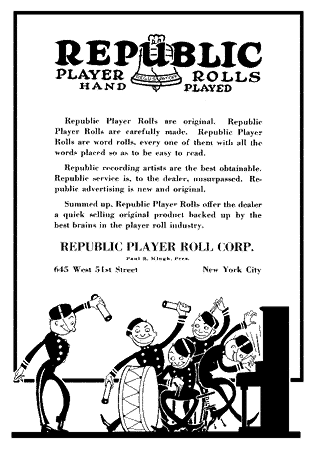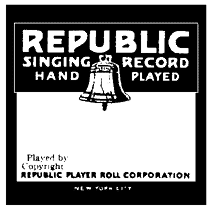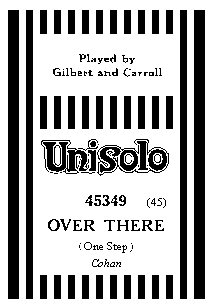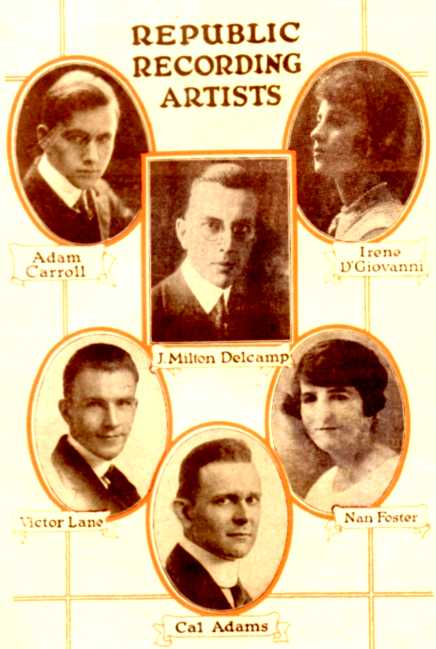| You Are Not Logged In | Login/Get New Account |
|
Please Log In. Accounts are free!
Logged In users are granted additional features including a more current version of the Archives and a simplified process for submitting articles. |
|
MMD
 Gallery
Gallery
 MMMedia
MMMedia
 Republic
Republic
|
|
651 West 51st Street, New York by Frank Himpsl (991128 MMDigest)
The outfit apparently started producing 88-note piano rolls around 1919, and this part of the business lasted only a few years. I believe that the "big name" Ampico stars, like Adam Carroll, J. Milton Delcamp and Frank Black, all had their piano-roll debut on either the Republic label or one of the cheaper subsidiary brands they issued. Around 1920 or 1921 the name of the firm was apparently changed to the DeLuxe Music Roll Corporation. They manufactured the Welte Licensee rolls, with the characteristic top hat brown boxes, and either "Welte Mignon" or "DeLuxe" printed in gold on the labels. Production of 88-note rolls seems to have stopped shortly after the firm got into manufacturing rolls for the Welte reproducing piano system. The Republic roll labels come in two types, each having a liberty bell design at top. One label is completely brown, the other is black bordered with the liberty bell design in red. The Republic subsidiary brands which I've seen are Unisolo (as Bryan mentioned), DeLuxe (this being NOT the Welte issues, but another 88-note roll label of different design), and Superior. The Unisolo and especially the Superior labels are very scarce today. Republic rolls sold at one dollar each, whereas the DeLuxe, Unisolo and Superior rolls were fifty or sixty cents. I've not been able to compare enough rolls side-by-side (i.e. Republic vs. the cheaper labels) to tell whether or not they actually abbreviated the music. Chances are they did not, and that the music of subsidiary labels is identical to the corresponding Republic issues. That is, assuming that all titles were issued on all labels. Connorized issued their identical 88-note rolls on the cheaper Dominant label, and these seem to all be the same masters. It is likely that Republic used somewhat cheaper paper on the other labels. The boxes are definitely of lesser quality. In addition to Carroll, Delcamp and Black, a number of other personalities appeared on the Republic series of 88-note rolls. These include songwriters like Clarence Gaskill and Charley Shisler, and jazz great Adrian Rollini. Even the great songwriter Maceo Pinkard's name is credited on a Republic roll or two. Blues and rags issued on the Republic labels are uniformly outstanding, and many of their pop song arrangements can rival other labels as QRS. The Carroll/Delcamp/Black presence together at the Republic roll shop in the days just following WW1 probably was the single most decisive factor in determining the smooth and classy "Ampico sound" which developed later. Frank Himpsl <fhimpsl@aol.com>
by Frank Himpsl (030607 MMDigest)
Click here for the original high-resolution image (875 kb).
For years we've seen these three artist names on Republic and Welte rolls: Cal Adams, Nan Foster and Victor Lane. The common assumption is that these were pseudonyms for either Adam Carroll or J. Milton Delcamp. I was very surprised recently to see an artist photo line-up on the inside back cover of the 1920 Republic roll catalog which includes pictures of three very real looking people -- Adams, Foster and Lane -- along with the familiar pictures of Adam Carroll and J. Milton Delcamp. I'm sending along an image scan of this page in hopes that someone might be able to shed light on who these people actually were. The Cal Adams / Adam Carroll connection is pretty hard to dismiss. Almost every Republic roll that I've heard that credits Cal Adams (as solo performer) I would have to definitely call an Adam Carroll performance, based on what I've learned about his early playing style and the high level of musicianship in these performances. On the other hand, Republic rolls credited to Lane or Foster are usually more generic sounding; certainly not stylistic to the extent that they could be linked with one of the "known real" artists. The four-hand arrangements, i.e., by Adams and Lane, etc., are very generic sounding, most likely intended as sing-a-long rolls with the usual marimba accompaniment line. Maybe Lane and Foster were company employees involved in the editing or perforating/stenciling, etc., of the rolls? Or was their job to turn out rolls of tunes that for whatever reason didn't appeal to Delcamp or Carroll? And who is this fellow pictured as Cal Adams, who certainly is Adam
Carroll in playing style? Maybe some day one of the photos
will turn up in a period music trades magazine and we'll be able to make
a connection from that. How sad that none of these folks are around
to tell us -- a minute with Adam Carroll would probably clear up the mystery
forever!
All best,
7 June 2003 |
|
|
|
|
|
|
|
|
|
CONTACT FORM: Click HERE to write to the editor, or to post a message about Mechanical Musical Instruments to the MMD Unless otherwise noted, all opinions are those of the individual authors and may not represent those of the editors. Compilation copyright 1995-2026 by Jody Kravitz. Please read our Republication Policy before copying information from or creating links to this web site. Click HERE to contact the webmaster regarding problems with the website. |
|
|
||||||
|
 In
reference to Bryan Cather's question about the Unisolo rolls, Unisolo was
a subsidiary brand of the Republic Player Roll Company, which was located
in New York City. I don't know the exact history behind this concern,
but I can report on what has become clear after some collecting and study.
In
reference to Bryan Cather's question about the Unisolo rolls, Unisolo was
a subsidiary brand of the Republic Player Roll Company, which was located
in New York City. I don't know the exact history behind this concern,
but I can report on what has become clear after some collecting and study.


